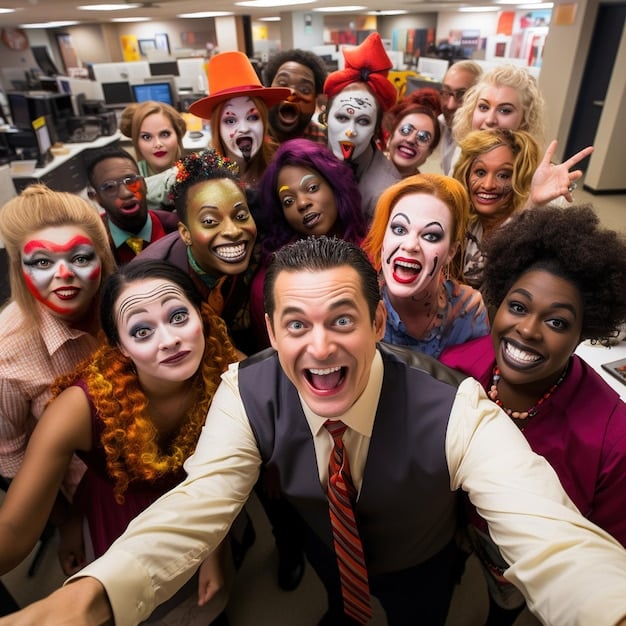The Power of Fandom: How Fan Communities Shape Entertainment

The power of fandom intricately shapes the entertainment industry by fostering community, amplifying voices, and driving economic trends through collective influence and passionate engagement worldwide.
In an increasingly interconnected world, understanding The Power of Fandom: How Fan Communities Shape the Entertainment Industry has become crucial. These dedicated collectives are no longer passive consumers but active participants, wielding significant influence over content creation, marketing strategies, and even the longevity of franchises. Their collective passion transforms mere viewership into a dynamic, two-way street, where creators and audiences engage in an unprecedented dialogue. This profound shift merits a closer look at the mechanisms and impacts of fandom.
The Evolution of Fandom: From Niche Subcultures to Mainstream Influence
Fandom, once relegated to the fringes of pop culture, has undergone a remarkable metamorphosis. What began as small, often isolated groups sharing a common interest in obscure texts, cult films, or niche music genres, has exploded into a global phenomenon. The digital age has been a primary catalyst, dismantling geographical barriers and enabling instantaneous, widespread connection among enthusiasts.
Historically, fans might have exchanged zines or attended limited conventions. Today, platforms like Reddit, Twitter, TikTok, and Discord serve as vibrant hubs where discussions flourish, theories are debated, and creative works are shared. This accessibility has democratized fandom, allowing diverse voices to converge and amplify their collective passion. The transition from private gatherings to public, online communities has fundamentally altered how the entertainment industry perceives and interacts with its most devoted consumers.
Digital Transformation and Community Building
The internet’s advent provided the necessary infrastructure for fandom to truly blossom. Online forums, fan fiction archives, and social media platforms became fertile ground for intricate networks to form, allowing individuals to find their tribe, irrespective of location. This digital expansion meant that niche interests could suddenly command significant attention and mobilize collective action.
- Forums & Message Boards: Early online spaces where fans could deep-dive into discussions, analyze plot points, and share insights the moment new content dropped.
- Social Media Amplification: Platforms like Twitter and Instagram enable rapid dissemination of fan theories, art, and campaigns, turning niche interests into trending topics.
- Dedicated Fan Platforms: Websites like Archive of Our Own (AO3) for fan fiction or specialized wikis become encyclopedic repositories of communal knowledge and creativity.
This digital infrastructure not only facilitated communication but also empowered fans to organize. From viral hashtags demanding continuation of beloved shows to crowdfunding campaigns for fan-created projects, the capacity for collective action grew exponentially. The entertainment industry, initially slow to recognize this shift, has gradually come to understand that engaging with these communities is paramount, not just for loyalty but for the very survival and expansion of their intellectual properties.
In essence, the evolution of fandom mirrors the broader societal shift towards connectivity and participation. What was once a solitary appreciation of content has become a dynamic, interactive experience, where the lines between creator and consumer are increasingly blurred. This evolving landscape sets the stage for fans to exert unparalleled influence.
Fan Activism and Its Impact on Production Decisions
The notion of “fan power” is not merely theoretical; it manifests concretely in the form of fan activism, significantly influencing production decisions across film, television, and gaming. Historically, creators held absolute sway over narratives, but the rise of organized fandom has introduced a powerful, demanding audience that expects to be heard.
One of the most vivid examples of this phenomenon is the “Save Our Show” campaigns. Franchises on the brink of cancellation have frequently been rescued by passionate fanbases whose coordinated efforts — be it through letter-writing campaigns, social media storms, or even fundraising — demonstrate their unwavering loyalty and economic viability. This activism often translates into renewed interest from networks or studios, recognizing the untapped commercial potential within these dedicated communities.
Crowdfunding and Greenlighting Projects
Beyond saving existing shows, fan activism has directly greenlit new projects or resurrected old ones through crowdfunding. Platforms like Kickstarter and Indiegogo have enabled fans to directly fund the production of films, games, albums, and even animated series that traditional studios might deem too risky or niche. This bypasses conventional gatekeepers, giving creators the freedom to pursue projects they know will resonate deeply with their audience.
- Veronica Mars Movie: A groundbreaking example where fans raised over $5.7 million on Kickstarter for a film continuation, proving their financial commitment.
- Shattered Heaven (Video Game): An indie game that successfully reached its funding goal due to a dedicated community’s belief in its premise.
- Mystery Science Theater 3000: Revived multiple times through fan-supported crowdfunding campaigns, showcasing sustained enthusiasm.
These successes send a clear message to the industry: a passionate fanbase is a valuable asset, not just in terms of viewership, but as direct investors. The risk assessment for a project changes dramatically when a pre-existing audience is willing to put their money where their mouth is. This also fosters a sense of co-ownership, making fans feel more invested in the success of the content.

Furthermore, fan activism extends to shaping narratives and character arcs. While creators largely retain artistic freedom, vocal fan feedback on issues like representation, plot holes, or character development can sometimes lead to adjustments in ongoing series. This is a delicate balance, as bowing too much to fan demands can stifle creativity, but ignoring legitimate concerns can alienate a crucial segment of the audience. The industry is learning to navigate this dynamic, recognizing that an engaged fanbase offers invaluable real-time analytics and feedback, albeit with strong opinions.
The power of the collective fan voice is undeniable. It shifts the dynamic from a one-way broadcast to a participatory ecosystem, where audience passion is a force capable of altering the very trajectory of entertainment properties. This activism demands attention and often redefines commercial viability.
Beyond Consumption: Fandom as a Creative Force
Fandom’s influence extends far beyond mere consumption and activism; it has evolved into a powerful creative force in its own right. Fans are not just passive recipients of entertainment but actively engage in transforming, expanding, and interpreting their beloved narratives. This creative output, often referred to as “fan works,” encompasses a vast array of forms, from written stories to intricate visual art, music, and even full-scale video productions.
Fan fiction is perhaps the most well-known manifestation of this creativity, allowing enthusiasts to explore alternative universes, delve deeper into character psyches, or simply continue stories beyond their official conclusion. These works often exhibit high levels of craftsmanship and originality, sometimes even influencing official canon or inspiring professional careers for their creators.
The Rise of Fan Media and Derivative Works
The spectrum of fan-created media is surprisingly broad and incredibly professional in its execution for many top-tier works. It’s a testament to the dedication and skill within these communities. This self-generated content serves not only as an outlet for creativity but also as a way to sustain engagement between official releases, keeping franchises vibrant in the public consciousness.
- Fan Films & Web Series: High-quality, often crowdfunded, cinematic endeavors that expand upon beloved franchises, like “Star Trek: Axanar” or various Batman fan films.
- Fan Art & Cosplay: Visual interpretations that celebrate characters, scenes, or concepts, contributing significantly to a franchise’s visual culture and marketing through viral sharing.
- Fan Music & Remixes: Original compositions or re-interpretations inspired by scores, themes, or narratives, often showcasing impressive musical talent.
These derivative works thrive in a unique legal and cultural space, operating under principles of fair use or often simply tolerated by copyright holders due to the positive impact they have on audience engagement and brand longevity. Many intellectual property owners have come to realize that fan creativity acts as powerful, unpaid marketing, keeping their properties relevant and fostering a deeper connection with the fanbase.
The relationship between fan creators and the official industry is complex but increasingly symbiotic. Some official projects have even directly hired professional fan artists or writers who honed their craft within fandom. This integration demonstrates a growing recognition that the creative energy within fan communities is a valuable resource, not merely a tangential activity.
Ultimately, fandom’s creative output enriches the entire entertainment ecosystem. It provides an avenue for diverse interpretations, sustains interest during content droughts, and offers a continuous feedback loop to official creators. This vibrant tapestry of fan-made media underscores fandom’s role not just as consumers, but as essential co-creators in the modern entertainment landscape.
Fandom’s Economic Influence and Market Trends
The economic footprint of fandom is substantial and multifaceted, extending beyond direct content consumption to encompass merchandise, conventions, and entire sub-industries built around fan interests. Entertainment companies have increasingly recognized that a passionate fanbase translates directly into robust revenue streams, not only through box office numbers or streaming subscriptions but through a myriad of related products and experiences.
Merchandise sales are a prime example. From action figures and apparel to collectibles and home decor, licensed products adorned with beloved characters or symbols generate billions of dollars annually. Fans, driven by their desire to showcase their loyalty and collect tangible representations of their affections, are primary purchasers. This segment alone is often a significant revenue driver, sometimes rivaling or even exceeding the original content’s earnings.
The Convention Economy and Live Experiences
Conventions, once small gatherings, have morphed into massive economic engines. Events like San Diego Comic-Con, New York Comic Con, and countless anime and gaming conventions attract hundreds of thousands of attendees, each spending on tickets, exclusive merchandise, celebrity autographs, and travel. These events are vital for generating hype, fostering community, and providing direct avenues for companies to engage with their hardcore fans.
- Ticket Sales: Major conventions command high prices for entry, reflecting the demand for unique, immersive experiences.
- Exclusive Merchandise: Limited-edition items sold only at conventions drive significant purchases and secondary market value.
- Travel & Hospitality: Attendees spend considerably on flights, hotels, and local amenities, boosting regional economies.

Beyond conventions, other live experiences tailored for fans, such as immersive theme park attractions, orchestral concerts featuring film scores, or interactive pop-up museums, also tap into this dedicated consumer base. These initiatives capitalize on the desire for deeper engagement and provide unique ways for fans to connect with their preferred franchises, further cementing their loyalty and generating additional revenue.
Furthermore, fandom drives market trends implicitly. When a particular genre or franchise gains strong fan traction, it signals to the industry where future investments might be profitable. Social media buzz, fan art volumes, and cosplay popularity often serve as informal market research, indicating areas of high consumer interest. This feedback loop can influence casting decisions, script development, and even the greenlighting of spin-offs or reboots. In essence, fandom isn’t just a passion; it’s a powerful economic indicator and a driving force in the entertainment market.
Understanding fandom’s economic influence is critical for industry players. Their purchasing power, combined with their collective voice in shaping market perception, makes them an indispensable force in the contemporary entertainment economy. Ignoring their trends or failing to engage them effectively is a missed opportunity for significant returns.
Fan-Industry Relations: Collaboration, Conflict, and Understanding
The relationship between fan communities and the entertainment industry is dynamic and complex, oscillating between periods of fruitful collaboration and occasional, heated conflict. As fans have gained more power and voice, the traditional top-down model of content creation has been challenged, forcing the industry to adapt to a more interactive and sometimes demanding audience.
On one hand, collaborations have become increasingly common and beneficial. Companies might engage fan artists for official merchandise designs, invite prominent fan theorists for special panels, or even incorporate fan-suggested elements into official narratives. This direct engagement fosters goodwill, strengthens community ties, and can serve as effective, authentic marketing. When done right, it makes fans feel valued and heard, deepening their investment in the franchise.
Navigating Copyright and Creative Control
However, this close relationship is not without its challenges. One of the most persistent areas of tension revolves around intellectual property and creative control. Fan works, by their nature, often utilize copyrighted material. While many companies adopt a permissive stance, understanding that fan content promotes their brand, others are more protective, leading to cease-and-desist orders that can sour fan relations.
- Official Intervention: When fan projects become too professional or monetize copyrighted elements, companies may step in to protect their IP, sometimes causing backlash.
- Narrative Disagreements: Fans sometimes clash vehemently with writers or directors over plot decisions, character fates, or perceived misrepresentations, leading to online protests and boycotts.
- Authenticity Concerns: Some fans view overt industry attempts to “cash in” on fandom trends or language as inauthentic or exploitative, preferring organic interactions.
The rise of social media has amplified both collaboration and conflict. While it allows for rapid dissemination of positive news and direct creator-fan interaction, it also provides a platform for swift, organized backlash against perceived missteps by the industry. Miscommunications, unpopular creative choices, or mishandling of fan expectations can go viral, significantly impacting public perception and brand reputation.
Understanding the nuances of fan-industry relations requires empathy, careful listening, and strategic communication from both sides. For the industry, it means recognizing that fans are more than just consumers; they are a passionate, invested community whose loyalty is a valuable asset. For fans, it means appreciating the complexities of large-scale production and intellectual property rights, even when creative choices don’t align with personal desires.
Successful navigation of this relationship hinges on open dialogue and mutual respect. The companies that thrive in the future will be those that learn to harness the positive energy of fandom while skillfully managing the inevitable friction points, transforming potential conflicts into opportunities for growth and deeper connection.
The Future of Fandom: Metaverse, AI, and Immersive Experiences
The landscape of fandom is continuously evolving, poised for profound transformations driven by emerging technologies such as the metaverse, artificial intelligence (AI), and increasingly immersive experiences. These innovations promise to blur the lines further between creation and consumption, opening up unprecedented avenues for fan engagement and influence.
The concept of the metaverse, a persistent, interconnected virtual world, holds immense potential for fandom. Imagine attending virtual concerts with thousands of fellow fans, directly interacting with avatars of your favorite characters, or even collaboratively building intricate fan-created worlds inspired by your beloved franchises. This level of immersion could redefine what it means to be a fan, moving beyond passive viewing to active participation within digital ecosystems.
AI’s Role in Personalized Fandom and Content Creation
Artificial intelligence is set to play a pivotal role in personalizing the fan experience and even assisting in content creation. AI algorithms can analyze fan preferences to recommend tailored content, merchandise, or events. More intriguingly, generative AI models could allow fans to create custom fan fiction scenarios, unique artwork, or even short animated clips with unprecedented ease, lowering the barrier to entry for creative expression.
- Personalized Experiences: AI could curate content feeds based on granular fan data, offering highly relevant news, discussions, and merchandise.
- Assisted Fan Creation: Tools powered by AI could help fans draft stories, design characters, or even compose music within their preferred franchise settings.
- Interactive Narratives: AI could enable more dynamic, responsive storytelling experiences where fan choices genuinely influence narrative progression in games or interactive media.
The rise of augmented and virtual reality (AR/VR) technologies also promises to deliver more immersive fan experiences. Attending a live sporting event with AR overlays providing real-time stats and fan polls, or stepping into a VR world where you can walk through famous fictional locations, could become commonplace. These technologies enhance the sense of presence and connection, making the fan experience richer and more interactive.
However, with these advancements come challenges. Issues of digital ownership, the ethical implications of AI-generated content, and ensuring equitable access to these immersive environments will need careful consideration. The industry will also face questions about how to monetize these new spaces without alienating fanbases who value authenticity and community over pure commercialization.
Ultimately, the future of fandom is likely to be characterized by greater interactivity, personalization, and creative opportunities made possible by technological innovation. Fans will continue to be at the forefront of driving these changes, pushing the boundaries of how we experience and participate in the entertainment we love. The industry capable of embracing these shifts while respecting the core tenets of fandom will be the one that thrives in the decades to come, fostering deeply engaged and influential communities that continue to shape the entertainment landscape.
| Key Aspect | Brief Description |
|---|---|
| 🌐 Community Growth | Digital platforms transformed fandom from niche groups into global, influential networks. |
| ✊ Fan Activism | Fans actively influence production, from saving shows to crowdfunding new content. |
| 🎨 Creative Output | Fan-made content (fiction, art, films) enriches franchises & drives engagement. |
| 💰 Economic Impact | Fandom fuels massive merchandise sales, convention economies, and market trends. |
Frequently Asked Questions
▼
Fan communities influence production through vocal feedback, social media campaigns, and direct funding via crowdfunding. Their collective voice can save shows from cancellation, greenlight new projects, and even shape narrative directions and character development in ongoing series. This demonstrates a shift from passive consumption to active, demanding participation, impacting critical decisions.
▼
“Fan activism” refers to organized efforts by fan communities to influence the entertainment industry. This includes campaigns like “Save Our Show” to prevent cancellations, advocating for diverse representation, or using crowdfunding to finance projects. It showcases fans’ power to mobilize, express opinions, and financially support content they believe in, challenging traditional industry gatekeepers.
▼
Fan-made creations, like fan fiction, art, and films, significantly impact official franchises by keeping them relevant between official releases. They foster deeper engagement, provide unpaid marketing, and can even influence creators or lead to professional opportunities for fan artists. While technically derivative, many companies tolerate these works due to their clear benefits in brand visibility and community strength.
▼
Fandom holds immense economic significance, driving billions in revenue through merchandise sales, convention attendance, and live experiences. Fans’ purchasing power directly supports intellectual property. Their collective interest also acts as a market indicator, influencing industry trends, investment decisions, and the development of new projects. Conventions alone inject substantial funds into local economies.
▼
New technologies like AI and the metaverse are poised to revolutionize fandom by enabling more immersive and personalized experiences. The metaverse could create virtual spaces for direct fan-character interaction and collaborative world-building. AI might personalize content recommendations and empower fans to create derivative works more easily. These advancements promise deeper engagement, though they also raise questions about ownership and access.
Conclusion
The undeniable power of fandom has profoundly reshaped the entertainment industry. No longer mere recipients, fan communities actively participate in content creation, influence production decisions, and drive significant economic value. Their passion fosters a dynamic ecosystem where creativity flourishes and boundaries blur. As technology continues to advance, the symbiotic relationship between fans and industry will only deepen, making it imperative for creators to authentically engage with these vital, influential communities. The future of entertainment is inherently intertwined with the relentless, creative, and powerful force of fandom.





